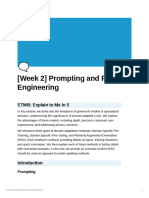0% found this document useful (0 votes)
115 views7 pagesPrompt Engineering Training
The document provides an overview of prompt engineering, emphasizing its significance in effectively interacting with large language models (LLMs) like ChatGPT and Gemini. It covers the definition, applications across various fields, types of prompts, and techniques for crafting effective prompts, along with common mistakes to avoid. Additionally, it discusses practical exercises, real-world applications, and ethical considerations in the responsible use of AI.
Uploaded by
kongudjCopyright
© © All Rights Reserved
We take content rights seriously. If you suspect this is your content, claim it here.
Available Formats
Download as DOCX, PDF, TXT or read online on Scribd
0% found this document useful (0 votes)
115 views7 pagesPrompt Engineering Training
The document provides an overview of prompt engineering, emphasizing its significance in effectively interacting with large language models (LLMs) like ChatGPT and Gemini. It covers the definition, applications across various fields, types of prompts, and techniques for crafting effective prompts, along with common mistakes to avoid. Additionally, it discusses practical exercises, real-world applications, and ethical considerations in the responsible use of AI.
Uploaded by
kongudjCopyright
© © All Rights Reserved
We take content rights seriously. If you suspect this is your content, claim it here.
Available Formats
Download as DOCX, PDF, TXT or read online on Scribd
/ 7





















































































































